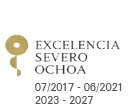Activity Detail
Seminar
The power of sugars
Antonio Molinaro
 Microbial cell surface molecules, such as the lipopolysaccharide, are very important cell wall glycoconjugates that act as microbe associated molecular patterns in eukaryotic/microbe recognition. Besides their general architectural principle, a number of subtle chemical variations are at the basis of the dynamic host-guest recognition that in case of pathogens is followed by the innate response and in case of symbiosis is followed by its suppression. Microbes differently from Eukaryotes have at their disposal an enormous array of monosaccharide structures/derivative by which they built up their external cell surface and drive their recognition by any eukaryotic host. Therefore, the chemical study of such glycoconjugates involved either as virulence or beneficial factors in animal or plant interactions is a pivotal pre-requisite for the comprehension at molecular level of the (innate) immunity mechanisms. [1]
Viral glycoproteins are usually meant to carry on eukaryotic glycans. Indeed, typically, viruses use host-encoded glycosyltransferases and glycosidases to add and remove sugar residues from virus glycoproteins. However, the more recently discovered large and giant viruses broke from this paradigm. Instead, these viruses code for an (almost) autonomous glycosylation pathway. Virus genes include the production of activated sugars, glycosyltransferases and other enzymes able to manipulate sugars at various levels.
Within this frame, a new class of glyco-molecules has been discovered with a novel and original architecture only belonging to giant viral world. [2]
By this communication, I will also show that structural Glycoscience of microbial world is a fascinating travel through astounding chemical structures with no parallel in any other kingdom.
Microbial cell surface molecules, such as the lipopolysaccharide, are very important cell wall glycoconjugates that act as microbe associated molecular patterns in eukaryotic/microbe recognition. Besides their general architectural principle, a number of subtle chemical variations are at the basis of the dynamic host-guest recognition that in case of pathogens is followed by the innate response and in case of symbiosis is followed by its suppression. Microbes differently from Eukaryotes have at their disposal an enormous array of monosaccharide structures/derivative by which they built up their external cell surface and drive their recognition by any eukaryotic host. Therefore, the chemical study of such glycoconjugates involved either as virulence or beneficial factors in animal or plant interactions is a pivotal pre-requisite for the comprehension at molecular level of the (innate) immunity mechanisms. [1]
Viral glycoproteins are usually meant to carry on eukaryotic glycans. Indeed, typically, viruses use host-encoded glycosyltransferases and glycosidases to add and remove sugar residues from virus glycoproteins. However, the more recently discovered large and giant viruses broke from this paradigm. Instead, these viruses code for an (almost) autonomous glycosylation pathway. Virus genes include the production of activated sugars, glycosyltransferases and other enzymes able to manipulate sugars at various levels.
Within this frame, a new class of glyco-molecules has been discovered with a novel and original architecture only belonging to giant viral world. [2]
By this communication, I will also show that structural Glycoscience of microbial world is a fascinating travel through astounding chemical structures with no parallel in any other kingdom.





